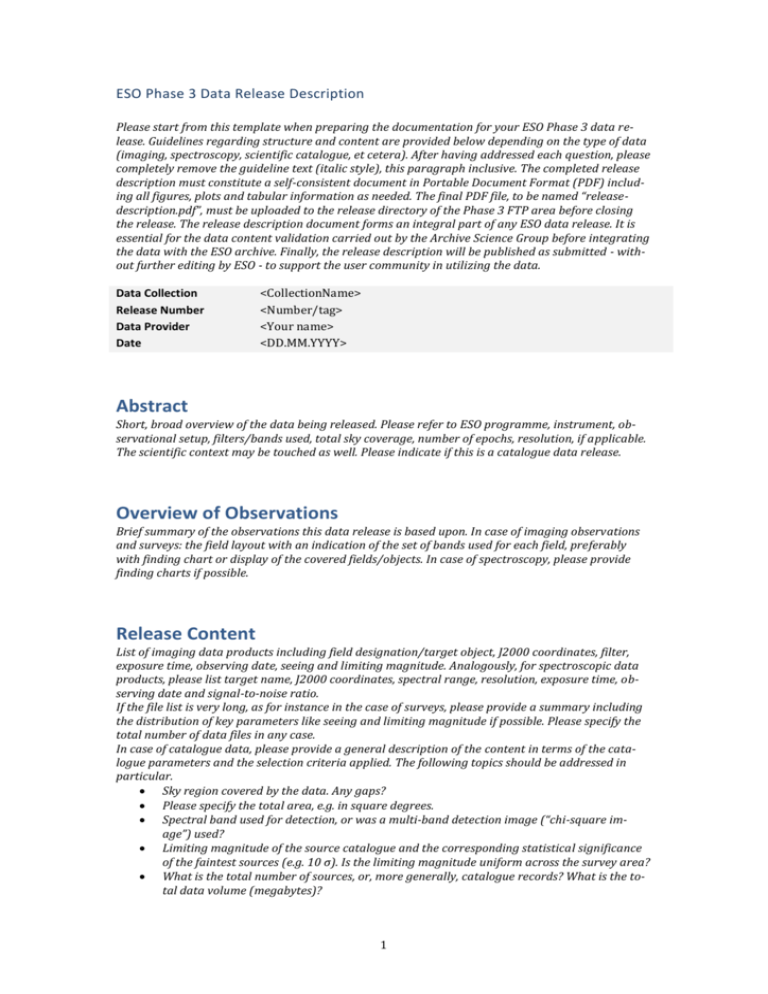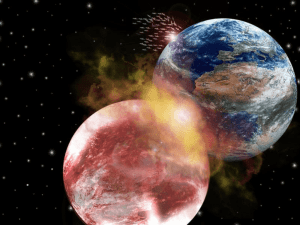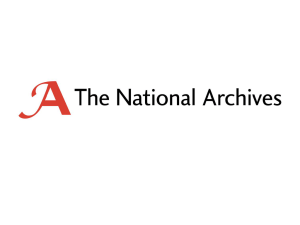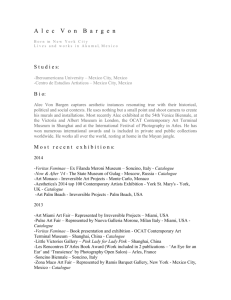Get template for the data release description
advertisement

ESO Phase 3 Data Release Description Please start from this template when preparing the documentation for your ESO Phase 3 data release. Guidelines regarding structure and content are provided below depending on the type of data (imaging, spectroscopy, scientific catalogue, et cetera). After having addressed each question, please completely remove the guideline text (italic style), this paragraph inclusive. The completed release description must constitute a self-consistent document in Portable Document Format (PDF) including all figures, plots and tabular information as needed. The final PDF file, to be named “releasedescription.pdf”, must be uploaded to the release directory of the Phase 3 FTP area before closing the release. The release description document forms an integral part of any ESO data release. It is essential for the data content validation carried out by the Archive Science Group before integrating the data with the ESO archive. Finally, the release description will be published as submitted - without further editing by ESO - to support the user community in utilizing the data. Data Collection Release Number Data Provider Date <CollectionName> <Number/tag> <Your name> <DD.MM.YYYY> Abstract Short, broad overview of the data being released. Please refer to ESO programme, instrument, observational setup, filters/bands used, total sky coverage, number of epochs, resolution, if applicable. The scientific context may be touched as well. Please indicate if this is a catalogue data release. Overview of Observations Brief summary of the observations this data release is based upon. In case of imaging observations and surveys: the field layout with an indication of the set of bands used for each field, preferably with finding chart or display of the covered fields/objects. In case of spectroscopy, please provide finding charts if possible. Release Content List of imaging data products including field designation/target object, J2000 coordinates, filter, exposure time, observing date, seeing and limiting magnitude. Analogously, for spectroscopic data products, please list target name, J2000 coordinates, spectral range, resolution, exposure time, observing date and signal-to-noise ratio. If the file list is very long, as for instance in the case of surveys, please provide a summary including the distribution of key parameters like seeing and limiting magnitude if possible. Please specify the total number of data files in any case. In case of catalogue data, please provide a general description of the content in terms of the catalogue parameters and the selection criteria applied. The following topics should be addressed in particular. Sky region covered by the data. Any gaps? Please specify the total area, e.g. in square degrees. Spectral band used for detection, or was a multi-band detection image (“chi-square image”) used? Limiting magnitude of the source catalogue and the corresponding statistical significance of the faintest sources (e.g. 10 σ). Is the limiting magnitude uniform across the survey area? What is the total number of sources, or, more generally, catalogue records? What is the total data volume (megabytes)? 1 Release Notes Short descriptions of the reduction methods used, the calibration procedures (astrometric, photometric, wavelength etc.), characterization of the data quality, and a comparison with previous releases where applicable. Data Reduction and Calibration Please address the following questions for scientific catalogue data, particularly in case of source catalogues: Which source detection method was used to generate the catalogue? Has the image been filtered before detection? Pls. specify the detection parameters (threshold, min. area, etc.) How were very bright stars, and imaging artifacts resulting thereof, handled? Illustrate the screening procedure that was followed to remove spurious sources and artifacts from the catalogue. Describe the process of merging overlapping survey tiles into one unique source catalogue (in case of surveys). Which reference was used to establish the astrometric calibration (GSC1, GSC2, USNO, 2MASS catalogue)? Specify the photometric reference system. Which procedure has been adopted to establish a global photometric calibration for surveys? Has the illumination effect been corrected for? If yes, what has been corrected, image pixels or source fluxes? Which corrections were applied to photometric measurements to account for seeing variations (e.g. aperture corrections, PSF matching)? Discuss the loss of flux due to finite apertures and the estimation of total flux for point sources. Discuss the effect of intergalactic extinction. Have fluxes/magnitudes been corrected for reddening? Data Quality Outline of the quality checks that were carried out on the data, including a discussion of the following topics (when applicable): Uniformity of the astrometric calibration across the survey region. Are there residuals due to individual detector chips or the tiling scheme of the survey? Is the zeropoint uniform across the tile/image? Discuss residuals due to chip-to-chip variations and the illumination effect. Uniformity of photometric calibration across the survey region, across different filters, and between different epochs. Quality of the colours indices? Quality of source parameters for point sources versus extended sources. Contamination of the source catalogue. What is the fractional amount of spurious objects at the faintest flux level? Quantification of catalogue completeness. Known issues if any Previous Releases This section only applies to subsequent releases having release numbers >1. Please quote the release numbers of previous Phase 3 releases for this data collection and list the changes in this release (N) with respect to the immediately preceding data release (N-1). 2 Data Format Files Types Description of the types of files in this release and the file naming conventions used. Catalogue Columns Please list label, data format, and description for each catalogue column. Acknowledgements Put here the acknowledgments to be included when using this data, usually referring to the scientific publication associated with the data, supplemented by the following boilerplate. Please use the following statement in your articles when using these data: Based on data products from observations made with ESO Telescopes at the La Silla Paranal Observatory under programme ID PPP.C-NNNN(R). 3











